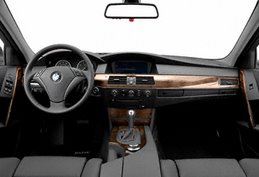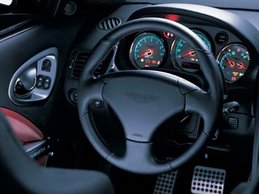 Honda Accord Hybrid - This primo Accord naturally has the highest price, about $30,000 base, Honda says, including automatic, leather, heated seats, AM-FM-satellite radio and six-CD changer, anti-lock brakes, and curtain airbags; the only option is a nav system.
Honda Accord Hybrid - This primo Accord naturally has the highest price, about $30,000 base, Honda says, including automatic, leather, heated seats, AM-FM-satellite radio and six-CD changer, anti-lock brakes, and curtain airbags; the only option is a nav system.The only sacrifices: You give up 2.8 cubic feet of cargo space (leaving 11.2) to make room for the traction battery and its ventilation system; the rear backrest no longer folds forward for access to the trunk; and the spare tire is replaced by a small air compressor and a can of sealant (Honda pioneered this approach to repairing flats on the original NSX). And, of course, you get whacked by something over three grand on the sticker, too.
Except for this small array of unusual graphics in the cluster, there's little about this car to say it's a hybrid, or that it's the best Accord. There's a small "hybrid" badge on the decklid, less conspicuous than the V-6 emblem below it, a token decklid spoiler, special five-spoke alloy wheels, a different grille color, and tires upsized one notch to 215/60R-16. The eye is hardly grabbed.
During our summer test motoring, the A/C was always running. The belt-drive compressor (75cc displacement) stops with the engine, but the electric compressor (15cc) maintains cabin coolness and keeps the Accord alive with enough vibration that you could think—in a Lexus anyway—the engine were still idling.

The 2997cc V-6 has a system to deactivate all the valves on the rear bank. It's programmed to shrink back to three-cylinder operation below 3500 rpm when cruising or coasting, and the others don't come alive even for mild acceleration. Instead, the electric motor readily and seamlessly kicks in to help.
The mechanical layout is typical of Honda hybrids, with a thin wafer of a motor/generator (Honda calls it Integrated Motor Assist) sandwiched between the sideways engine and transmission. The five-speed automatic was shortened by 2.4 inches to allow room between the frame rails for the extra 2.7 inches of the IMA.
We tried a full-power launch one morning on damp—but definitely not wet—pavement; the tires stayed on the squealing side of full traction all the way to 30 mph.
The IMA, of course, changes its act to become a generator on de
 celeration, acting as a brake and sending the recaptured energy back to the battery. Progress keeps coming. Honda says the 2005 Accord's regen efficiency is 95.2 percent, up from the 2003 hybrid Civic's 93.5 percent.
celeration, acting as a brake and sending the recaptured energy back to the battery. Progress keeps coming. Honda says the 2005 Accord's regen efficiency is 95.2 percent, up from the 2003 hybrid Civic's 93.5 percent.This Honda's hybrid machinery is relatively simple, but a densely wound motor and an Ni-MH battery pack of 13.8 kilowatt-hours add pounds. To at least partly offset the gains, the hybrid substitutes aluminum for the hood, bumper beams, and rear suspension uprights; magnesium for the intake manifold and head cover; and remember, there's no spare tire.
The usual question about hybrids—"Can you save enough gas to pay back the extra initial cost?"—doesn't apply here.













No comments:
Post a Comment